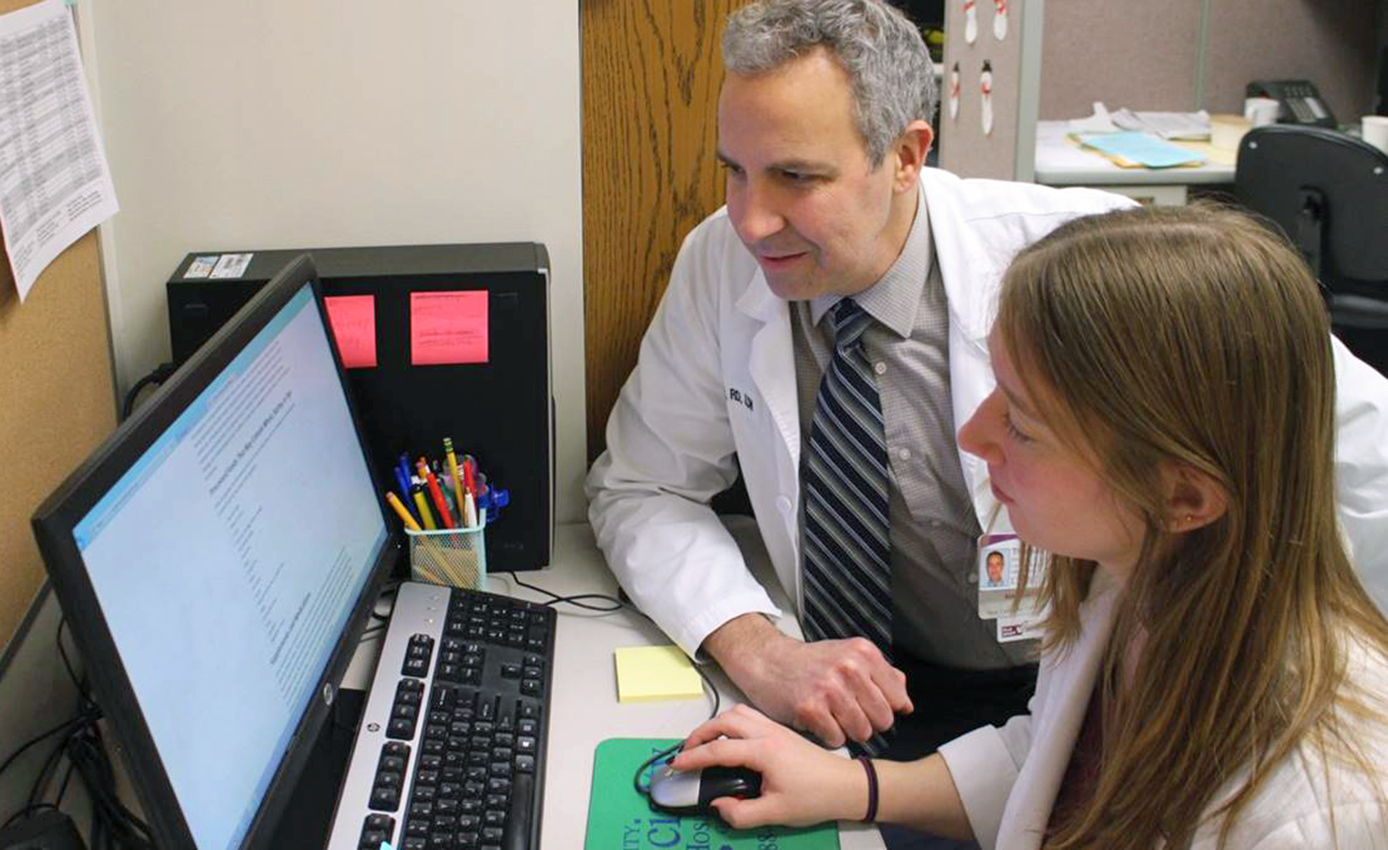
Subscribe to Pittwire Today
Get the most interesting and important stories from the University of Pittsburgh.Nutrition and Dietetics Program Offering Balanced Diet of Clinical Experiences
This story originally appeared in the spring/summer 2017 issue of FACETS, the magazine of the School of Health and Rehabilitation Sciences.
Students in Pitt’s nutrition and dietetics master’s program have a voracious appetite for learning, and Tom Hritz (SHRS ’03, ’07G; EDUC ’11G) makes sure they get their fill.
As the clinical nutrition manager for UPMC Mercy and Magee-Womens Hospital of UPMC, Hritz has been welcoming students into the clinic with him for nearly 13 years.
“The best place for students to gain experience working with all disease states is in a clinical setting, particularly an acute care setting,” said Hritz. “Clinical nutrition is the foundation for any area in which a dietitian will work throughout his or her career.”
Dietitians are experts in nutrition who work in settings such as hospitals, schools, community health, research and even the food industry. In health care settings, they often assess and plan diets for patients and advise them on their eating habits; they also monitor supplemental nutrition such as feeding tubes. Generally, training involves a bachelor’s degree in an accredited dietetics program, 1,200 hours of post-baccalaureate supervised practice and passing the national registration exam. Some practitioners choose to continue their education in a master's or PhD program.
As researchers learn more about how food and nutrients nourish the body, there’s greater need for a workforce of dietitians to apply that knowledge. Hritz is helping train that next generation.
“Tom served as my preceptor at UPMC Mercy during my internship year,” recalled Laura Maydak (SHRS ’13, ’15G). “He was always thorough in his explanations of projects, performance expectations and a dietitian’s role in the clinical setting.
“While he provided me with necessary baseline guidance, he encouraged me to think both critically and creatively to meet the needs of our individual patients and our hospital as a whole,” she said.
Hritz, who focused on wellness as it relates to human performance for his master's research and exercise physiology for his PhD program, places a high value on teaching students how and when to apply clinical judgment and skill when developing nutrition care plans to meet the goals that the clinical team has established for each patient.
That may sound obvious, but consider the challenge that dietitians face when they’re responsible for preparing approximately 500 patient meals per day at Magee, and 900 at UPMC Mercy. “It’s critical for students to understand that every patient’s course of care does not follow a textbook example,” said Hritz.
Experience in hospitals like Mercy and Magee really strengthens what students are learning in the classroom.
Tom Hritz, alumnus and clinical nutrition manager for UPMC Mercy and Magee-Womens Hospital of UPMC
Interns working under Hritz and his team follow a rigorous schedule. They begin with four weeks in the food service department, where they learn about product flow, ordering and inventory. From there they progress to clinical work.
“Students become familiar with reading electronic health records and thinking about how medications, lab results or physician notes might impact the patient’s nutritional needs,” Hritz explained. “This is also when students start to interact with patients to learn their nutritional risk levels.
“Experience in hospitals like Mercy and Magee really strengthens what students are learning in the classroom,” Hritz said. “They may be aware that patients will have different and multi-layered health issues, but here they actually see how important it is for a dietitian to prioritize patient needs and solve problems one at a time.”
Over the course of their internship year, students work with patients diagnosed with a variety of illnesses including diabetes, renal disease, cancer and gastrointestinal diseases, as well as those in critical and long-term care. They eventually move on to a rotation where they follow their own set of patients and develop nutritional care plans, under the watchful eye of their supervisors.
In the process, they learn the role of the clinical dietitian.
“Tom was all about teamwork,” said Liz Dunn (SHRS ’14, ’16G). “He made it clear that the dietitians were a team in which everyone could step up and help out when time allowed. He also created a very comfortable environment for me to work in.
Dunn acknowledged that at first, she felt intimidated to express her opinions. “But Tom made himself accessible to me whenever I had questions. His way of creating a positive work environment and allowing everyone, even students, to work as productive members of the team helped everyone reach their goals.”
Recent intern Molly Westbrook (SHRS ’17) agreed that Hritz was a tremendous role model.
“From the first day of my internship, Tom has given me a lot of autonomy. He is allowing me to develop my own style, and gives me the independence to manage my own time,” said Westbrook at the time. “Under Tom’s guidance I’ve learned to be a professional and caring manager.”
Trisha A. Cousins, clinical coordinator and instructor in the Coordinated Master in Nutrition and Dietetics program, praised Hritz for his dedication to developing the next generation of clinical dietitians. “Tom’s leadership and initiative are what shapes him to be one of the best clinical nutrition managers I have ever worked with as a clinical coordinator,” said Cousins.



